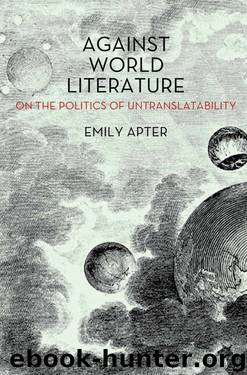Against World Literature by Emily Apter

Author:Emily Apter
Language: eng
Format: epub
Publisher: Verso Books
Technically speaking, a fibril is a fiber or cable-like string of cellulose binding plant cell walls or holding in place the cylindrical structure of spirochetes; those wiggly, worm-like bacteria most famously and ignominiously associated with syphilis. The fibril depicted here fibrillates in the manner of a vocal chord. Glissant writes, “Within the ship’s space the cry of the departed was stifled, as it would be in the realm of the Plantations. This confrontation still reverberates to this day.”15
Another philosophical cartography for “world” would have appeared if the Vocabulaire had extended its mandate to creolized or exogamous forms of French, not to mention non-European languages. Discussions of the difference between the Arabic words (or a’lam, which refers to countries of the world) and (or dunya, which refers to the world we live in now as opposed to the world after death); between the Swahili word dunia (world) and Ulimwengu (universe); or the Mandarin compound (or shì, which refers to life, age, generation, era, world, lifetime) plus jiè (boundary, scope, extent, circles, group, kingdom) would have added worldliness to the definition of world. The translational tension in the term vishwa sahitya (roughly “literatures of the world”) is particularly rich. Vinay Dharwadker maintains that its range of definitions for world encompasses “world literature, universal literature, universalistic literature, and cosmopolitan literature” in contradistinction to that for rashtriya sahitya (roughly “national literature” in modern subcontinental languages), with rashtra (nation) harking back to a Sanskrit word for “territory, country, kingdom, empire, and the people or subjects of a realm.”16
For some literary critics, the worlds of literature are mapped in a combative arena of competing literary nationalisms (Pascale Casanova) and emergent literary world-systems (as in Giuseppe Cocco’s notion of Brazil’s “becoming-world,” dubbed “monde-Brés”). For others, the worlds of literature are thinkable as data systems based on quantitative indices of plot and style, as suggested by Franco Moretti. For others still, worlds are constituted in literature by the techniques of totalizing aesthetics: panoramic perspective or realism (elaborated as a continuum between fictional mimesis and the “real” world, as argued recently by Tiphaine Samoyault). And, if we take into account the factors identified by former editor at Pantheon Books, André Schiffrin, a literary world must be defined by forms of self-censorship that affect a book before it reaches publication. This thoroughly capitalized literary world-system assumes that authors internalize commercial values and mediate their textual productions with projections of price points and sales figures.17
Without necessarily taking on the full complement of phenomenological philosophies of “world” that lead inexorably to Heidegger’s abandoned structures of in-dwelling (the Abbau, or original temple), where metaphysics runs aground, there are also interrogations of the “globe” in globalization that philosophically complicate the world in world literatures. One key example is Jean-Luc Nancy’s The Creation of the World or Globalization, which builds on his earlier book The Sense of the World, and brings to light the manifold differences between “globalization” (the crushing uni-totality of the network society) and mondialisation (a creative “world-forming”), not to mention the more subtle distinctions between the English “globalization” and the French globalisation.
Download
This site does not store any files on its server. We only index and link to content provided by other sites. Please contact the content providers to delete copyright contents if any and email us, we'll remove relevant links or contents immediately.
| Books & Reading | Comparative Literature |
| Criticism & Theory | Genres & Styles |
| Movements & Periods | Reference |
| Regional & Cultural | Women Authors |
4 3 2 1: A Novel by Paul Auster(12283)
The handmaid's tale by Margaret Atwood(7679)
Giovanni's Room by James Baldwin(7191)
Asking the Right Questions: A Guide to Critical Thinking by M. Neil Browne & Stuart M. Keeley(5635)
Big Magic: Creative Living Beyond Fear by Elizabeth Gilbert(5610)
Ego Is the Enemy by Ryan Holiday(5294)
The Body: A Guide for Occupants by Bill Bryson(4974)
On Writing A Memoir of the Craft by Stephen King(4863)
Ken Follett - World without end by Ken Follett(4645)
Adulting by Kelly Williams Brown(4487)
Bluets by Maggie Nelson(4473)
Eat That Frog! by Brian Tracy(4435)
Guilty Pleasures by Laurell K Hamilton(4360)
The Poetry of Pablo Neruda by Pablo Neruda(4039)
Alive: The Story of the Andes Survivors by Piers Paul Read(3968)
White Noise - A Novel by Don DeLillo(3954)
Fingerprints of the Gods by Graham Hancock(3942)
The Book of Joy by Dalai Lama(3899)
The Bookshop by Penelope Fitzgerald(3775)
